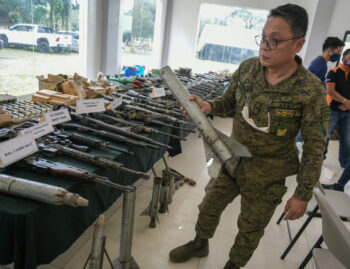NAAWAN, Misamis Oriental (MindaNews/18 October) — Damn elastic and endless deadlines! The President finally declared on Tuesday, 17 October 2017, the liberation of Marawi from the ISIS-Maute terrorists, without waiting anymore for the military to completely annihilate or cause the surrender of some 30 or so who are still making probably their last stand in some rat holes at Ground Zero.
The announcement was greeted with joy and exultations by the various stakeholders of the city, particularly by those who have been languishing in crowded infernal evacuation centers remote from the battle zone. The evacuees had long prayed for the end of the war so they could go home and be spared from further humiliation and suffering in evacuation centers.
Without access to TV, many evacuees have no idea about the extent of the war, of the havoc and the devastation it brought to their beloved homeland.

It is doubtful if their return to the city can be facilitated in a week’s or even in a month’s time. Sufficient time is needed to eradicate the threat and clear the place of the recalcitrant terrorists, of the IEDs and bobby traps left behind in their escape; and from the hazards of collapsing buildings; and to sanitize the place from rotting carcasses and disease-carrying vermin. There is practically no standing structure, even the semblance of the hated evacuation centers, to accommodate hundreds of thousands of returnees. There’s no power and water; and no commerce of food supplies and medicines to support and assure life. There is practically nothing. There would only be disappointment and anger. And, perhaps, some little, however fragile, hope.
If a few would be allowed a glance of the city before the great exodus back, expect gnashing of teeth and raging outbursts at the sight of the crumbles and rubbles of what they once adored.
It took nearly five months for the government and its security forces to end the Marawi siege. Suffice it to say that it was easier doing that than reconstructing the city from the ravages of the conflict.
The huge question is how to proceed with the biggest project the country will undertake for the first time in history. Will the new Marawi rise from the ruins of the old city or in an unblemished place nearby still along the legendary Lake Lanao?
There might be virtue in preserving the ruins and rubbles of old Marawi as war memorial, a testament to the cruelty and stupidity of war. This may yet make Marawi a tourist destination, a development that could break its isolation from mainstream economic and social development.
For planners and developers it is easier and cheaper to start on new grounds where visions and plans can be approached full swing, rather than on the old confines where legal and historical dynamics may cause so much delay and setbacks in project implementation.
Regardless of sites, after the life-support systems – power, water, road and sewerage networks – have been established, the next order of the day is in building the dwellings of former Marawi residents. Would it be high-rise tenements/ apartments or individual housing units to replace those destroyed by the war, or a combination, meaning, high-rise communal housing and some individual housing units?
What would be the basis of allocating units to beneficiaries? This is a little thorny subject. Past property records are difficult to produce. Many if not all claims would be anecdotal and extremely difficult to validate.
Once power or influence politics crawls into the issue, there would be hell to pay. A new uprising may erupt even before a new city can start breathing.
(MindaViews is the opinion section of MindaNews. William R. Adan, Ph.D., is retired professor and former chancellor of Mindanao State University at Naawan, Misamis Oriental.)







